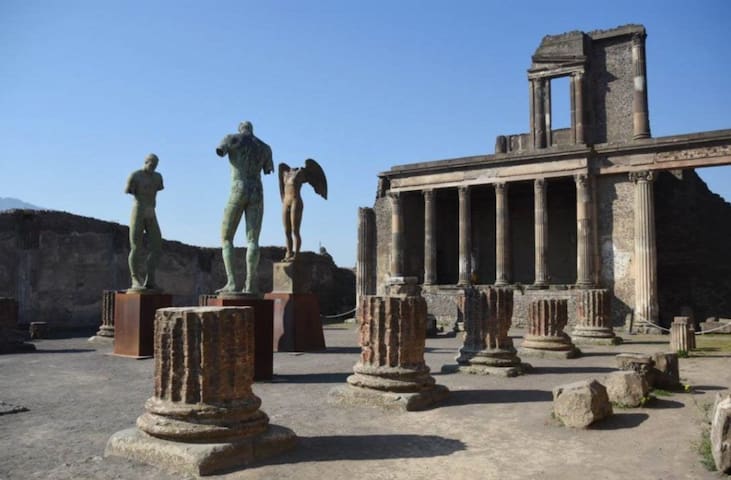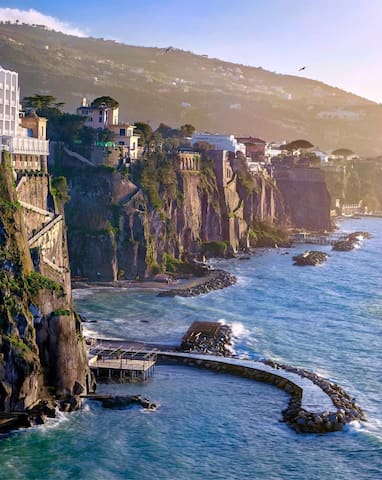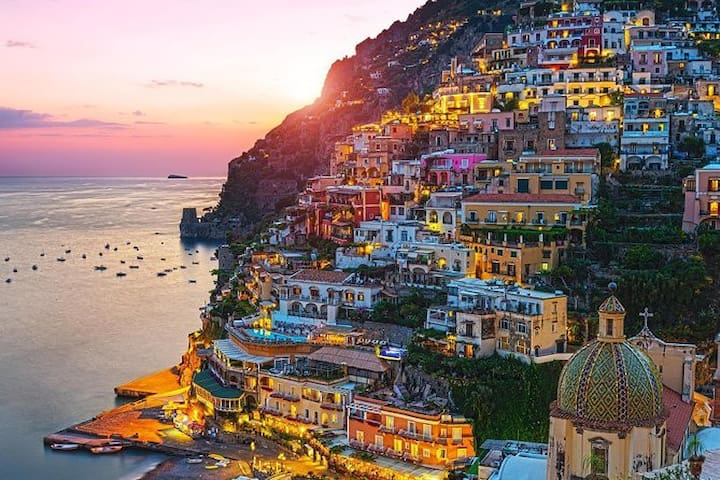Visite turistiche
The Amalfi Coast is located just below Naples on the southern side of the Sorrentine Peninsula in Campania. The 50-kilometer stretch of coastline is a UNESCO World Heritage Site and is comprised of dozens of towns, beaches, coves and cliffs. The most famous of these are Positano, Amalfi and Ravello, though there are a number of other picturesque towns along the Amalfi Coast that are well worth a visit. Positano and Amalfi have the most accommodations and are easy to reach by land or sea so they are an optimal base for exploring the area or making a trip to Capri during your stay.
Pompeii was an ancient Roman city located in the modern comune of Pompei near Naples in the Campania region of Italy. Pompeii, along with Herculaneum and many villas in the surrounding area (e.g. at Boscoreale, Stabiae), was buried under 4 to 6 m (13 to 20 ft) of volcanic ash and pumice in the eruption of Mont Vesuvius in AD 79. Largely preserved under the ash, the excavated city offers a unique snapshot of Roman life, frozen at the moment it was buried and providing an extraordinarily detailed insight into the everyday life of its inhabitants. It was a wealthy town, enjoying many fine public buildings and luxurious private houses with lavish decorations, furnishings and works of art which were the main attractions for the early excavators. Organic remains, including wooden objects and human bodies, were entombed in the ash and decayed leaving voids which archaeologists found could be used as moulds to make plaster casts of unique and often gruesome figures in their final moments of life. The numerous graffiti carved on the walls and inside rooms provide a wealth of examples of the largely lost Vulgar Latin spoken colloquially at the time, contrasting with the formal language of the classical writers. Pompeii is a UNESCO World Heritage Site status and is one of the most popular tourist attractions in Italy, with approximately 2.5 million visitors annually. After many excavations prior to 1960 that had uncovered most of the city but left it in decay, further major excavations were banned and instead they were limited to targeted, prioritised areas. In 2018, these led to new discoveries in some previously unexplored areas of the city.
504 recommandé par les habitants
Pompei
Pompeii was an ancient Roman city located in the modern comune of Pompei near Naples in the Campania region of Italy. Pompeii, along with Herculaneum and many villas in the surrounding area (e.g. at Boscoreale, Stabiae), was buried under 4 to 6 m (13 to 20 ft) of volcanic ash and pumice in the eruption of Mont Vesuvius in AD 79. Largely preserved under the ash, the excavated city offers a unique snapshot of Roman life, frozen at the moment it was buried and providing an extraordinarily detailed insight into the everyday life of its inhabitants. It was a wealthy town, enjoying many fine public buildings and luxurious private houses with lavish decorations, furnishings and works of art which were the main attractions for the early excavators. Organic remains, including wooden objects and human bodies, were entombed in the ash and decayed leaving voids which archaeologists found could be used as moulds to make plaster casts of unique and often gruesome figures in their final moments of life. The numerous graffiti carved on the walls and inside rooms provide a wealth of examples of the largely lost Vulgar Latin spoken colloquially at the time, contrasting with the formal language of the classical writers. Pompeii is a UNESCO World Heritage Site status and is one of the most popular tourist attractions in Italy, with approximately 2.5 million visitors annually. After many excavations prior to 1960 that had uncovered most of the city but left it in decay, further major excavations were banned and instead they were limited to targeted, prioritised areas. In 2018, these led to new discoveries in some previously unexplored areas of the city.
Firstly guests should bring with them comfortable shoes for walking as so there are so many rocky roads in Pompeii. Is better to enter city from Villa dei Misteri side as untill Piazza Anfiteatro along walking roads getting down step by step, as from Piazza Immacolata to Santa Mauro Superiore roads needs to climb on rocky massive.
352 recommandé par les habitants
Parc archéologique de Pompéi
2 Via PlinioFirstly guests should bring with them comfortable shoes for walking as so there are so many rocky roads in Pompeii. Is better to enter city from Villa dei Misteri side as untill Piazza Anfiteatro along walking roads getting down step by step, as from Piazza Immacolata to Santa Mauro Superiore roads needs to climb on rocky massive.
Sorrento is a town overlooking the Bay of Naples in Southern Italy. It is a popular tourist destination due to its variety of small antique shops and location on the Amalfi Coast. The town is most known for its small shops selling ceramics, lacework and marquetry (woodwork). The Sorrentine Peninsula has views of Naples, Vesuvius and the Isle of Capri. The Amalfi Drive, connecting Sorrento and Amalfi, is a narrow road that threads along the high cliffs above the Tyrrhenian Sea. Ferries and hydrofoils connect the town to Naples, Amalfi, Positano, Capri and Ischia. Sorrento's sea cliffs and luxury hotels have attracted a lot of celebrities. Limoncello, a digestif made from lemon rinds, alcohol, water and sugar, is produced in Sorrento. Other agricultural production includes citrus fruit, wine, nuts and olives.
625 recommandé par les habitants
Sorrento
Sorrento is a town overlooking the Bay of Naples in Southern Italy. It is a popular tourist destination due to its variety of small antique shops and location on the Amalfi Coast. The town is most known for its small shops selling ceramics, lacework and marquetry (woodwork). The Sorrentine Peninsula has views of Naples, Vesuvius and the Isle of Capri. The Amalfi Drive, connecting Sorrento and Amalfi, is a narrow road that threads along the high cliffs above the Tyrrhenian Sea. Ferries and hydrofoils connect the town to Naples, Amalfi, Positano, Capri and Ischia. Sorrento's sea cliffs and luxury hotels have attracted a lot of celebrities. Limoncello, a digestif made from lemon rinds, alcohol, water and sugar, is produced in Sorrento. Other agricultural production includes citrus fruit, wine, nuts and olives.
Dramatic, deluxe and more than a little dashing, Positano is the Amalfi Coast's front-cover splash, with vertiginous houses tumbling down to the sea in a cascade of sun-bleached peach, pink and terracotta. No less photo-worthy are its steep streets and steps, flanked by wisteria-draped hotels, smart restaurants and fashionable retailers.
593 recommandé par les habitants
Positano
Dramatic, deluxe and more than a little dashing, Positano is the Amalfi Coast's front-cover splash, with vertiginous houses tumbling down to the sea in a cascade of sun-bleached peach, pink and terracotta. No less photo-worthy are its steep streets and steps, flanked by wisteria-draped hotels, smart restaurants and fashionable retailers.
Amalfi is a town and comune in the province of Salerno, in the region of Campania, Italy, on the Gulf of Salerno. It lies at the mouth of a deep ravine, at the foot of Monte Cerreto (1,315 metres, 4,314 feet), surrounded by dramatic cliffs and coastal scenery. The town of Amalfi was the capital of the maritime republic known as the Duchy of Amalfi, an important trading power in the Mediterranean between 839 and around 1200. In the 1920s and 1930s, Amalfi was a popular holiday destination for the British upper class and aristocracy. Amalfi is the main town of the coast on which it is located, named Costiera Amalfitana (Amalfi Coast), and is today an important tourist destination together with other towns on the same coast, such as Positano, Ravello and others.
440 recommandé par les habitants
Amalfi
Amalfi is a town and comune in the province of Salerno, in the region of Campania, Italy, on the Gulf of Salerno. It lies at the mouth of a deep ravine, at the foot of Monte Cerreto (1,315 metres, 4,314 feet), surrounded by dramatic cliffs and coastal scenery. The town of Amalfi was the capital of the maritime republic known as the Duchy of Amalfi, an important trading power in the Mediterranean between 839 and around 1200. In the 1920s and 1930s, Amalfi was a popular holiday destination for the British upper class and aristocracy. Amalfi is the main town of the coast on which it is located, named Costiera Amalfitana (Amalfi Coast), and is today an important tourist destination together with other towns on the same coast, such as Positano, Ravello and others.





